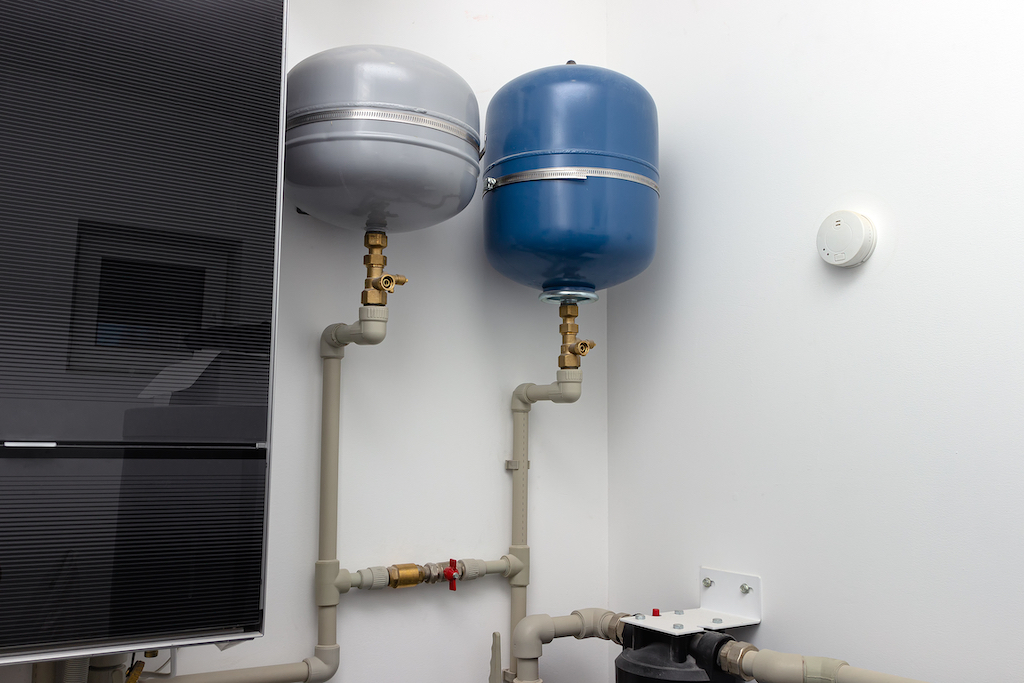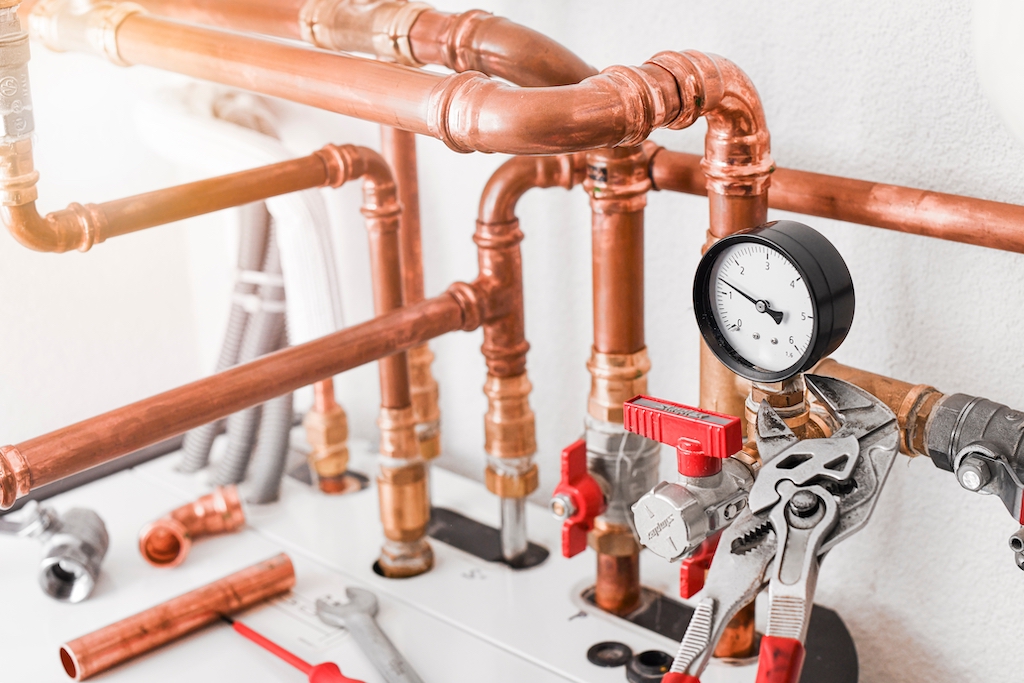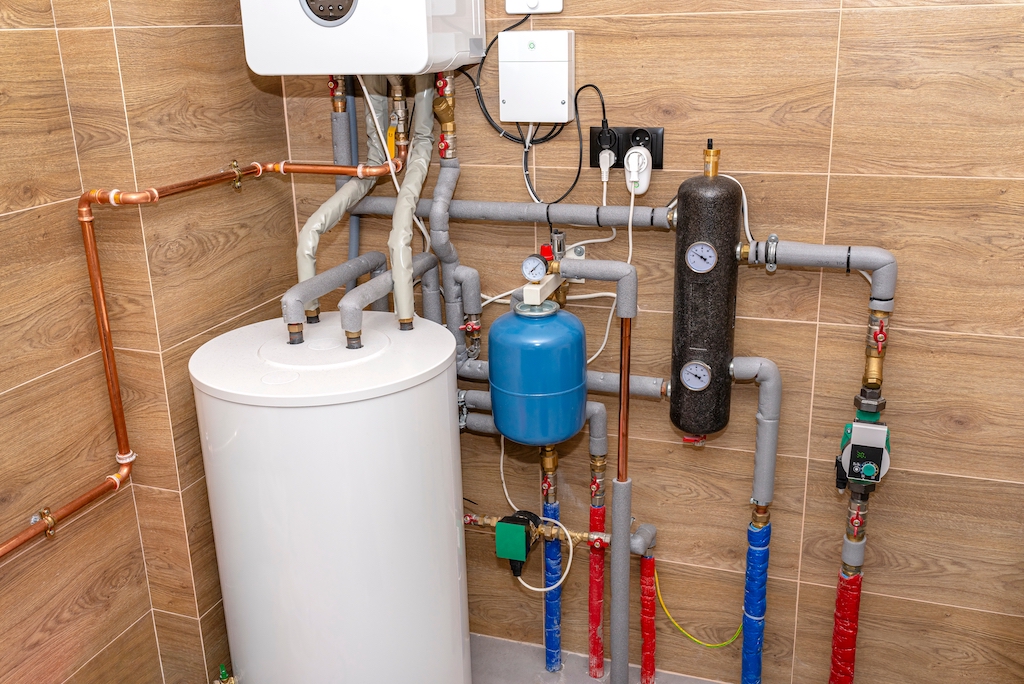
Water Heater Expansion Tanks: A Comprehensive Guide
Have you ever heard a strange noise coming from your water heater or noticed water leaking around it?
These could be signs that your plumbing system is under too much pressure, a common issue that homeowners face.
Luckily, there’s a straightforward solution that not only protects your water heater but also extends its lifespan: the water heater expansion tank.
In this article, we’ll dive deep into everything you need to know about water heater expansion tanks. From understanding their crucial role in your home’s plumbing system to learning how to maintain them, we’ll cover the ins and outs to ensure you’re well-equipped to handle your water heater’s needs.
Whether you’re a new homeowner or looking to brush up on your maintenance skills, this guide will provide valuable insights and practical tips.
Also read: Quick Fix: Tankless Water Heater Repair Guide
What is a Water Heater Expansion Tank?
A water heater expansion tank is a crucial component of your home’s plumbing system, specifically designed to mitigate the risks associated with thermal expansion in water heaters. Thermal expansion occurs when water is heated and expands, increasing its volume.
In a closed plumbing system, this expansion creates additional pressure, which, if not properly managed, can lead to significant problems.
Without a place for this extra water to go, pressure can build up within your system, putting stress on water pipes, the water heater, and other plumbing fixtures.
Over time, this can result in leaks, damaged fixtures, or even a burst water heater tank, leading to potentially costly repairs.
The water heater expansion tank works by giving the expanded water a place to flow into, thereby relieving pressure on the system. It’s a small tank, partially filled with air, whose design complements the closed water system by absorbing the excess water volume.
The tank is divided into two sections by a rubber diaphragm. One side is connected to the plumbing system and fills with water, while the other side contains air under pressure.
As water volume expands, it pushes into the tank, compressing the air in the other half. This action effectively absorbs the shock of thermal expansion, stabilizing the pressure within the system.
Installing a water heater expansion tank is not just a precautionary measure but a requirement in many areas, particularly in modern homes with backflow preventers or check valves that create a closed system. These devices prevent the backward flow of water, making an expansion tank essential for pressure relief.
It’s a small investment that protects your home from the potential havoc of unchecked pressure, ensuring the longevity and efficiency of your water heating system.
Including a water heater expansion tank in your plumbing setup provides peace of mind, knowing your home is safeguarded against the risks of thermal expansion.
Water heater expansion tanks are not just an accessory but a necessity for many homes, especially those equipped with modern plumbing systems.
The primary role of an expansion tank is to accommodate the expanded volume of water that results from heating, thus preventing pressure increases that could harm your plumbing infrastructure.
Also read: The Ultimate Guide To Hiring A Bathroom Plumber: Everything You Need To Know

Photo By Krasula at iStock
Why Expansion Tanks Are Crucial
Protecting Against Pressure Damage
As water heats up and expands, it seeks more space, and without an outlet, this increased volume creates significant pressure within your home’s plumbing system. This pressure can strain pipes, jo
Compliance with Local ints, and the water heater itself, potentially leading to leaks, ruptures, or the premature failure of the water heater.
Water heater expansion tanks provide a safety net by absorbing the excess water and pressure, thereby safeguarding your system from these high-pressure scenarios.Building Codes
In many jurisdictions, the installation of an expansion tank is more than just a recommendation; it’s a requirement.
Building codes have evolved to recognize the importance of these tanks in preventing damage and ensuring the safety and efficiency of plumbing systems.
Compliance with these codes not only ensures your plumbing system’s integrity but also keeps you in line with local regulations, avoiding potential legal and insurance complications.
The Impact of Backflow Preventers and Check Valves
Modern plumbing systems often include backflow preventers or check valves to stop contaminated water from flowing back into the clean water supply.
While these components are essential for maintaining water quality, they also create a closed system that does not allow excess pressure to dissipate back into the municipal water lines.
This setup makes the role of a water heater expansion tank even more critical, as it becomes the primary avenue for pressure relief within the system.
Ensuring System Longevity and Efficiency
By installing a water heater expansion tank, homeowners can significantly extend the lifespan of their plumbing and water heating systems. These tanks not only prevent structural damage caused by excessive pressure but also contribute to the overall efficiency and reliability of the system.
Regular maintenance of the expansion tank, such as checking the air pressure and inspecting for signs of wear or damage, further enhances its effectiveness and ensures continuous protection for your plumbing infrastructure.
The necessity of water heater expansion tanks in modern homes cannot be overstated.
They play a vital role in maintaining the health of your plumbing system, complying with building codes, and ensuring the safety and comfort of your living environment.
Types of Expansion Tanks
When it comes to managing the pressure caused by thermal expansion in your home’s water heating system, understanding the different types of expansion tanks is crucial.
Primarily, there are two categories tailored to specific systems: thermal expansion tanks for water heaters and hydronic expansion tanks for boiler systems.
Each plays a vital role in maintaining the integrity and efficiency of your home’s heating system, but their functionalities and applications differ significantly.
Thermal Expansion Tanks for Water Heaters
Thermal expansion tanks are specifically engineered to serve water heater systems. These tanks are designed to absorb the excess water volume generated when water is heated, thus preventing the buildup of excess pressure within the system.
Equipped with a rubber diaphragm that separates the tank into two chambers—one for water and one for air—they adjust to the pressure changes by allowing the expanded water to push against the diaphragm, compressing the air on the other side.
This process effectively mitigates pressure increases and protects your water heater and plumbing from potential damage.
The selection of a thermal expansion tank depends on the capacity of your water heater and the typical pressure levels in your plumbing system.
It’s essential to choose a tank that matches these specifications to ensure optimal performance and protection.
Hydronic Expansion Tanks for Boiler Systems
Hydronic expansion tanks are utilized within boiler systems that heat water for radiators or baseboard heating systems.
Unlike their counterparts for water heaters, hydronic tanks manage the expansion of water caused by heating in a closed-loop system. These tanks are critical for maintaining a consistent pressure level throughout the heating cycle, ensuring the system operates efficiently and safely.
Hydronic expansion tanks also feature a diaphragm or bladder but are specifically calibrated for the temperatures and pressures unique to boiler systems.
They play a key role in preventing pressure-related issues such as noisy operation, frequent relief valve discharge, and even system failure.
How to Choose the Right Expansion Tank
Selecting the appropriate water heater expansion tank involves considering several factors, including the type of heating system you have, the system’s capacity, and the specific pressure requirements.
For water heaters, a thermal expansion tank is necessary to handle the expansion directly associated with domestic hot water heating.
In contrast, a hydronic expansion tank is suited for systems that circulate water for space heating.
Consulting with a plumbing professional can provide valuable insights into the exact specifications required for your system, ensuring you choose the right type of expansion tank.
Proper installation and regular maintenance are also crucial to the tank’s performance and longevity, highlighting the importance of understanding the specific needs of your water heating or boiler system.
Recognizing the Need for an Expansion Tank
Incorporating a water heater expansion tank into your plumbing system is not just about adhering to building codes or enhancing the system’s efficiency—it’s a critical measure to prevent potential damage and ensure the longevity of your water heating system.
Recognizing the signs that indicate the need for an expansion tank is essential for maintaining the health of your plumbing infrastructure.
Fluctuations in Water Pressure
One of the most noticeable signs that might indicate the need for an expansion tank is fluctuations in water pressure.
If you experience sudden drops or spikes in water pressure, especially during or after water usage, it’s a clear indication that your system is struggling to manage the thermal expansion effectively.
These pressure changes can stress your plumbing fixtures and connections, leading to leaks or damage over time.
Visible Leaks Around the Water Heater
Another telltale sign is the presence of visible leaks around your water heater.
While leaks can have several causes, consistent or recurring leakage might suggest that excess pressure within the system is forcing water to escape through the weakest points.
Installing a water heater expansion tank can alleviate this pressure, reducing the risk of leaks and the associated water damage.
Noises from the Water Heater
Unusual noises emanating from your water heater, such as banging, knocking, or gurgling sounds, should not be ignored. These noises often result from water hammer or the rapid closing and opening of valves, which can occur when the system is under too much pressure.
An expansion tank helps to cushion the shock and minimize these noises, indicating a more stable and pressure-balanced system.
The Importance of an Expansion Tank
Understanding these signs and taking timely action can save you from costly repairs and replacements down the line.
A water heater expansion tank is a relatively small investment that plays a significant role in protecting your plumbing system from the adverse effects of thermal expansion. It acts as a buffer, absorbing excess water volume and maintaining a stable pressure level within the system.
If you’re noticing any of these symptoms, it may be time to consult with a plumbing professional to evaluate your need for an expansion tank.
Ensuring your system is equipped to handle thermal expansion not only safeguards your plumbing but also contributes to the overall efficiency and longevity of your water heating system.
Making the Right Choice: Selecting Your Expansion Tank
Choosing the appropriate water heater expansion tank is a critical decision that can significantly influence the efficiency and durability of your plumbing system. This decision involves understanding the specific requirements of your water heating system and the operational dynamics of your home’s plumbing.
Here’s a step-by-step guide to ensuring you select the best expansion tank for your needs.
Assess Your Water Heater’s Capacity
Understanding Capacity Requirements
The capacity of your water heater is the starting point in determining the size of the expansion tank you need.
A larger water heater, typically measured in gallons, will require a larger expansion tank to accommodate the increased volume of water that expands when heated.
Matching Tank Size to Heater Capacity
It’s essential to match the expansion tank’s capacity with your water heater’s output to ensure that it can effectively handle the thermal expansion.
Manufacturers often provide charts or calculators that help homeowners choose the correct size based on their water heater’s capacity and the system’s pressure settings.
Evaluate Your Plumbing System’s Pressure
Knowing Your System’s Pressure
The pressure of your plumbing system plays a crucial role in selecting the right water heater expansion tank. It’s important to know the typical pressure settings to ensure the expansion tank can properly manage the system’s pressure variations.
Adjusting for Pressure Requirements
Expansion tanks come with a pre-charge pressure, which should be adjusted to match your plumbing system’s pressure. This alignment is vital for the tank to function correctly, absorbing the expanded water and preventing pressure from building up in the system.
Consult with a Professional
Leveraging Expertise
While homeowners can do preliminary research, consulting with a plumbing professional provides invaluable insights. A professional can assess your system’s specific needs, considering factors like water usage patterns, the presence of additional pressure regulation devices, and local building codes that might influence the type of expansion tank required.
Customizing Your Selection
A professional consultation ensures that your selection is not just based on generic guidelines but is tailored to the unique aspects of your home’s plumbing system.
This personalized approach guarantees that your water heater expansion tank will deliver optimal performance, safeguarding your system against the potential risks of thermal expansion.
Choosing the right expansion tank is a nuanced process that balances various factors, including the capacity of your water heater, the pressure of your plumbing system, and the specific requirements of your home.
By carefully assessing these aspects and seeking professional guidance, you can ensure that your expansion tank enhances the safety, efficiency, and longevity of your water heating system.
Ensure Optimal Performance through Installation and Maintenance
A water heater expansion tank is pivotal in maintaining the efficiency and longevity of your home’s plumbing system. However, its effectiveness hinges on proper installation and diligent maintenance practices.
Understanding the nuances of these processes can significantly impact the tank’s performance and the overall health of your water heating system.
Proper Installation of Expansion Tanks
Selecting the Right Size and Type
The first step towards a successful installation is selecting the right size and type of expansion tank.
This choice should be based on your water heater’s capacity and the typical pressure settings of your plumbing system. A tank too small may not adequately handle the volume of expanded water, while one too large could unnecessarily strain your system.
Positioning and Connection
Correct positioning and secure connection to the water heating system are crucial. The tank should be installed on the cold water supply line, ideally near the water heater, to effectively manage the thermal expansion.
It’s essential to follow manufacturer instructions and local building codes to ensure optimal placement and installation.
Routine Maintenance for Expansion Tanks
Checking Air Pressure
Regular maintenance should include checking the air pressure in the expansion tank to ensure it matches the water pressure in your system. This typically involves using a standard air pressure gauge.
The pre-charge pressure of the tank should be adjusted to equal the water pressure, a critical step usually performed during installation and periodically thereafter to maintain efficiency.
Inspecting for Wear and Damage
Over time, expansion tanks can experience wear or damage, such as diaphragm failures or corrosion.
Conducting regular inspections can help identify these issues early, allowing for timely replacements or repairs. Visual inspections for signs of leakage or corrosion, especially around the tank’s fittings, are important preventative measures.
Ensuring Longevity and Efficiency
Routine maintenance not only extends the lifespan of the water heater expansion tank but also ensures the consistent performance of your water heating system.
Scheduling annual inspections by a qualified professional can prevent minor issues from escalating into major problems, ultimately saving time, money, and the inconvenience of system failures.
Adhering to these installation and maintenance guidelines is essential for maximizing the benefits of your water heater expansion tank.
By taking proactive steps to ensure its proper function, homeowners can enjoy a more efficient, reliable, and safe water heating system.
Navigating the Choice: DIY vs. Professional Installation of Water Heater Expansion Tanks
When it comes to installing a water heater expansion tank, homeowners are often faced with the decision of whether to tackle the project themselves or to enlist the expertise of a professional. This choice significantly impacts the effectiveness and reliability of the installation.
Understanding the pros and cons of each approach is crucial for making an informed decision that ensures the longevity and efficiency of your plumbing system.
DIY Installation: Empowering Homeowners
Advantages of DIY Installation
For the handy homeowner, DIY installation of a water heater expansion tank can be a rewarding project. It offers an opportunity to understand the plumbing system better and can result in cost savings on labor.
With a plethora of online tutorials and guides, motivated individuals can acquire the necessary knowledge to undertake this task.
Considerations and Challenges
However, the DIY route comes with its challenges. It requires a certain level of skill, the right tools, and a comprehensive understanding of your home’s plumbing system.
Incorrect installation can lead to system malfunctions, such as inadequate pressure relief or even tank damage.
Additionally, there’s the risk of voiding warranties on your water heater or the expansion tank if the installation is not performed according to the manufacturer’s specifications.
Professional Installation: Ensuring Expertise
The Benefit of Professional Experience
Opting for professional installation brings the expertise of licensed plumbers who are familiar with the nuances of water heater expansion tanks and local building codes.
Professionals can ensure that the tank is correctly sized, properly installed, and optimally integrated with your plumbing system. Their experience can also identify and preempt potential issues, providing peace of mind that the installation is done right.
Cost vs. Long-Term Reliability
While professional installation involves higher upfront costs compared to DIY, it guarantees the job’s accuracy. This investment can prevent costly repairs or damage resulting from improper installation.
Professionals also offer warranties on their work, adding an extra layer of protection for homeowners.
Making Your Decision
Choosing between DIY and professional installation of a water heater expansion tank boils down to balancing the desire for cost savings with the need for a reliable and correctly installed system.
If you have confidence in your skills and access to the necessary tools, DIY installation might be a viable option.
However, for those seeking assurance that their system is up to code and free from installation errors, professional installation is the recommended path. Regardless of the choice, ensuring the expansion tank is correctly installed is paramount for the safety and efficiency of your home’s water heating system.
Here’s everything else you need to know about maintaining your water heater and ensuring it runs efficiently for years to come.

Photo By Kinek00 at iStock
Enhance Your Home Safety with Water Heater Expansion Tanks
Water heater expansion tanks play a vital role in maintaining the integrity and efficiency of your home’s water heating system.
By effectively managing the pressure caused by thermal expansion, these tanks prevent potential damage to your plumbing and ensure the system operates smoothly.
Understanding the broader benefits and considerations of incorporating a water heater expansion tank into your home can provide you with peace of mind and contribute to a safer, more efficient household.
The Science Behind Thermal Expansion
When water is heated, it expands. This fundamental property of thermal expansion can cause increased pressure within a closed water heating system.
A water heater expansion tank is designed to absorb this excess pressure by providing a cushion of air for the expanded water to compress against, thus preventing the pressure from reaching dangerous levels that could damage your plumbing system.
Preventive Measures for Home Safety
The installation of a water heater expansion tank is a proactive measure that homeowners can take to protect their property.
By mitigating the risks associated with excessive pressure, such as burst pipes or a ruptured water heater tank, these expansion tanks serve as an insurance policy against costly repairs and potential water damage to your home.
The peace of mind that comes from knowing your home is protected from such risks is invaluable, making the expansion tank an essential component of a well-maintained plumbing system.
Long-Term Benefits and Savings
In addition to preventing immediate damage, a water heater expansion tank can offer long-term benefits to homeowners.
By ensuring that your water heating system operates within safe pressure levels, these tanks can extend the lifespan of your water heater and other plumbing components. This not only saves you money on potential repairs and replacements but can also contribute to more consistent water pressure and better overall performance of your water heating system.
Moreover, some insurance policies may favor homes that take proactive measures to prevent plumbing failures, potentially leading to lower insurance premiums.
The investment in a water heater expansion tank, therefore, not only safeguards your home but can also be financially advantageous in the long run.
Choosing the Right Solution for Your Home
Selecting the correct water heater expansion tank involves understanding the specific needs of your water heating system, including the capacity of your water heater and the typical pressure in your plumbing system.
Consulting with plumbing professionals can help ensure that you choose a tank that provides the optimal balance of safety, efficiency, and cost-effectiveness for your home.
A water heater expansion tank is more than just an accessory to your water heating system; it is a critical component that enhances the safety, efficiency, and longevity of your home’s plumbing.
By understanding the importance of these tanks and investing in the right solution, homeowners can enjoy the benefits of a well-protected and efficiently operating water heating system.

Photo By Rizwan Mehmood at iStock
Top 5 Tested and Proven Maintenance Tips For Your Water Heater Expansion Tank
When it comes to optimizing the performance and longevity of your water heater expansion tank, understanding and implementing key strategies and tips can make a significant difference.
Let’s delve deeper into these insights, ensuring your system operates at its best.
-
Proper System Pressure Regulation
The Importance of Stability
Maintaining stable system pressure is critical in any water heating system. An expansion tank that’s properly set up plays a pivotal role in this process, absorbing excess pressure and preventing the common pitfalls of thermal expansion, such as leaks or structural damage to the tank.
The aim is to maintain pressure within a predefined safe range, thus avoiding the triggering of the emergency relief valve, which can be a clear sign of system distress.
Key Practices for Pressure Management
Regular monitoring and adjustments are essential to keep the system within operational norms.
This might involve adjusting the pre-charge pressure of the expansion tank to match the main water pressure, ensuring the system functions smoothly without abrupt pressure changes that could harm the system.
-
Understanding the Water Heater Expansion Tank Market
Staying Informed
The market for water heater expansion tanks is continually evolving, with new advancements and technologies emerging.
Staying informed about these developments can empower homeowners and professionals alike to make informed decisions, selecting products that enhance efficiency and reliability.
Leveraging Market Trends
By understanding market trends, you can anticipate changes in regulations, availability of more advanced solutions, and opportunities to upgrade your system for better performance and energy efficiency.
This proactive approach ensures your water heating system remains up-to-date with the latest industry standards and technologies.
-
Expansion Tank Dos and Don’ts
Installation Insights
Correct installation is paramount.
For instance, mounting the expansion tank vertically with the connection at the top is a best practice that facilitates proper functioning and longevity. Regular checks of the air pressure are also crucial to ensure it aligns with your system’s needs, preventing over or under-expansion.
Maintenance Musts
Avoid common pitfalls by adhering to a routine maintenance schedule. This involves inspecting the tank for signs of wear, checking for leaks, and ensuring the air pressure is correctly set.
These steps are vital to safeguarding the integrity of your plumbing system.
-
Properly Sizing an Expansion Tank
Accurate Assessment
The size of your expansion tank should be directly related to the capacity of your water heater and the typical pressure settings of your plumbing system.
An accurately sized tank is essential for handling the expanded volume of water efficiently, ensuring the system maintains balance without compromising on safety or performance.
Consulting Experts
Utilizing resources such as instructional videos or consulting with professionals can provide valuable guidance in selecting the right size for your expansion tank, tailoring the choice to your system’s specific requirements.
-
Regular Maintenance Checks
Ensuring System Health
Routine inspections play a critical role in the long-term health of your expansion tank.
Verifying air pressure, checking for wear and tear, and looking for potential leaks are all practices that can help preempt and address issues before they escalate into costly repairs.
Schedule and Professional Support
Establishing a consistent maintenance schedule, possibly with the assistance of a plumbing professional, ensures your system remains in top condition, providing reliable service while minimizing the risk of unexpected failures.
By embracing these strategies and tips, you can enhance the management and maintenance of your water heater expansion tank, ensuring it contributes effectively to the overall efficiency and reliability of your water heating system.
Bluefrog Plumbing + Drain North Dallas: Your Expert in Water Heater Expansion Tanks
Navigating the complexities of water heater expansion tanks requires expertise and precision. Bluefrog Plumbing + Drain North Dallas stands out as a beacon of reliability and professionalism in this specialized field.
Our commitment to excellence ensures that every aspect of your water heater expansion tank installation, maintenance, or replacement is handled with unmatched skill and attention to detail.
Unmatched Expertise and Service
Professional Installation
At Bluefrog Plumbing + Drain North Dallas, we understand the critical role that a properly installed water heater expansion tank plays in the overall health and efficiency of your plumbing system.
Our team of licensed professionals is equipped with the latest tools and knowledge to ensure your expansion tank is installed correctly, adhering to all local codes and manufacturer guidelines.
Whether you’re setting up a new tank or replacing an old one, our experts are here to provide seamless service.
Comprehensive Maintenance
Regular maintenance is key to the longevity and efficiency of your water heater expansion tank.
Our services include thorough inspections, pressure checks, and adjustments to ensure your tank operates within safe parameters. By identifying and addressing potential issues early, we help prevent costly repairs and extend the life of your expansion tank.
Serving the North Dallas Community
Local Presence
Bluefrog Plumbing + Drain North Dallas proudly serves several key areas within the North Dallas region, including Denton, TX, Irving, TX, Carrollton, TX, and Richardson, TX.
Our deep understanding of the local plumbing systems and regulations ensures that our services are not only effective but also compliant with all local standards.
Ready to Assist
Understanding that plumbing issues can arise unexpectedly, we’re committed to providing timely and responsive services to our community.
Whether you need immediate assistance with a malfunctioning expansion tank or seek to schedule routine maintenance, our team is just a phone call away.
Reach out to us at 469-573-2535 for prompt and professional help.
To learn more about our services and see firsthand the quality of our work, we invite you to visit our Google Page. Here, you’ll find reviews and ratings from our satisfied customers, showcasing our dedication to excellence and customer satisfaction.
At Bluefrog Plumbing + Drain North Dallas, we’re more than just a plumbing service; we’re your trusted partner in ensuring the safety and efficiency of your home’s plumbing system. Contact us today to experience the difference our expertise and commitment can make in managing your water heater expansion tank needs.
Conclusion
The role of a water heater expansion tank in maintaining the health and efficiency of your home’s water heating system cannot be overstated. These tanks play a pivotal role in managing the thermal expansion that naturally occurs as water heats up, effectively preventing the potential dangers of increased pressure within your plumbing system.
Proper understanding, selection, and maintenance of these expansion tanks are key to ensuring the smooth operation of your water system, safeguarding against leaks, and enhancing the overall longevity of your water heater.
Choosing the right expansion tank is the first step towards a well-protected plumbing system. It involves considering the size of your water heater and the specific pressure requirements of your home.
Following up with professional installation ensures that your tank is correctly integrated into your plumbing system, providing optimal performance from the get-go.
Regular maintenance, including pressure checks and inspections, further ensures that your expansion tank continues to function effectively, helping you to avoid unnecessary repairs and maintain efficiency.
By adhering to these guidelines, you not only comply with local building codes but also contribute to a more energy-efficient home.
We invite you to share your experiences or any tips you might have regarding water heater expansion tanks in the comments below. Your insights could help others navigate their own plumbing system improvements, fostering a community of well-informed homeowners.

Photo By Sviatlana Herasimenka at iStock
FAQs
- Do I really need a water heater expansion tank?
Yes, especially if you have a closed plumbing system. An expansion tank helps manage pressure increases caused by thermal expansion, protecting your system from damage.
- How do I know if my expansion tank is failing?
Signs of a failing expansion tank include visible leaks, a waterlogged tank, or fluctuating water pressure in your home. If you notice any of these signs, it’s time to inspect or replace your tank.
- Can I install an expansion tank myself?
While it’s possible for DIY-savvy homeowners to install an expansion tank, it’s recommended to hire a professional. Proper installation is crucial for the tank to function correctly.
- How often should an expansion tank be replaced?
The lifespan of an expansion tank varies, but it’s a good idea to inspect it every few years as part of your regular home maintenance routine. Replacement might be necessary if it shows signs of wear or damage.
- What size expansion tank do I need?
The size of the expansion tank you need depends on the size of your water heater and the pressure of your water supply. A professional plumber can help you determine the right size for your system.
6.Can I install a water heater expansion tank on an existing system?
Yes, a water heater expansion tank can be added to an existing water heating system.
7.How often should a water heater expansion tank be replaced?
The lifespan of a water heater expansion tank varies depending on several factors, including the quality of the tank, the conditions of your water heating system, and how well it’s maintained. On average, an expansion tank can last between 5 to 10 years. ‘
Read our previous blog post.
Check out this tip!
Alan Soukup




















